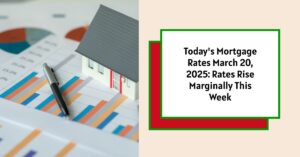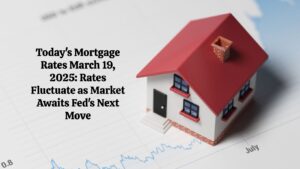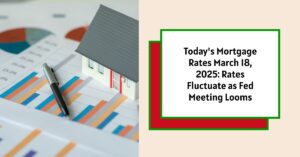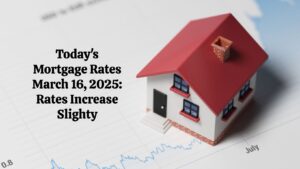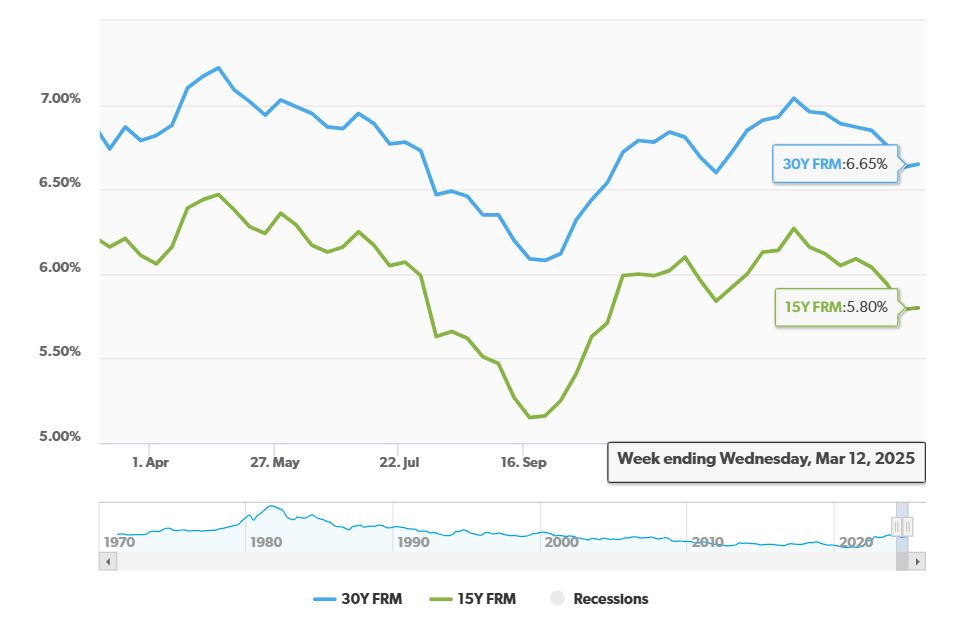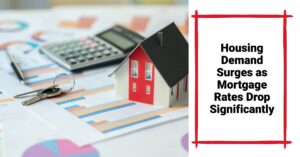As of March 21, 2025, mortgage rates have seen a slight dip following the Federal Reserve's recent meeting. While this offers a bit of relief for prospective homebuyers and those considering refinancing, the overall outlook for significant rate drops this year remains uncertain.
Today's Mortgage Rates March 21, 2025: Rates See a Modest Drop
Key Takeaways:
- Mortgage rates for a 30-year fixed loan are averaging around 6.58%.
- Refinance rates are generally in line with purchase rates, with a 30-year fixed refinance averaging 6.61%.
- Rates saw a slight decrease after the Federal Reserve announced it would maintain the federal funds rate.
- The Fed projects two rate cuts in 2025, which could lead to further easing of mortgage rates.
- However, there's uncertainty as some Fed policymakers anticipate fewer or no rate cuts.
- Affordability remains a concern, and it's unclear if the expected rate drops will significantly improve it.
Current Mortgage Rates
According to data provided by Zillow, here's a snapshot of today's average mortgage rates as of March 21, 2025:
| Mortgage type | Average rate today |
|---|---|
| 30-year fixed | 6.58% |
| 20-year fixed | 6.17% |
| 15-year fixed | 5.83% |
| 7/1 ARM | 7.23% |
| 5/1 ARM | 6.60% |
| 30-year FHA | 5.75% |
| 30-year VA | 6.05% |
It's interesting to note the subtle differences across various loan types. The 30-year fixed rate remains the most common choice for its predictable monthly payments, even though it typically comes with a slightly higher interest rate compared to shorter-term options like the 15-year fixed rate. The appeal of a fixed rate is the peace of mind that your payments won't fluctuate over the life of the loan.
Adjustable-rate mortgages (ARMs), such as the 7/1 and 5/1 ARMs, currently have rates that are quite competitive with fixed-rate options. However, it's important to remember that these rates are fixed only for an initial period (seven or five years, respectively), after which they can adjust based on prevailing market conditions. While they might offer a lower initial payment, they carry the risk of payment increases down the line.
For eligible borrowers, FHA and VA loans continue to offer attractive interest rates. These government-backed loans are designed to make homeownership more accessible, particularly for first-time homebuyers and veterans. The lower rates associated with these loans can significantly impact the overall cost of homeownership.
Mortgage Refinance Rates Today
For homeowners looking to potentially lower their monthly payments or shorten their loan term, understanding today's refinance rates is crucial. Here’s what the average refinance rates look like on March 21, 2025, based on Zillow's data:
| Mortgage type | Average rate today |
|---|---|
| 30-year fixed refinance | 6.61% |
| 20-year fixed refinance | 6.22% |
| 15-year fixed refinance | 5.99% |
| 7/1 ARM refinance | 6.98% |
| 5/1 ARM refinance | 7.56% |
| 30-year FHA refinance | 5.80% |
| 30-year VA refinance | 6.12% |
As you can see, refinance rates are closely aligned with the rates for new purchase mortgages. This makes sense, as the underlying economic factors influencing interest rates affect both markets similarly. Whether refinancing makes financial sense depends on individual circumstances, such as the difference between your current interest rate and the available refinance rates, as well as the associated closing costs.
Many financial professionals suggest that a rate reduction of at least one percentage point is a good benchmark for considering a refinance. However, this isn't a strict rule, and even a smaller reduction could be beneficial depending on the loan amount and the homeowner's financial goals. For example, someone with a very large mortgage balance might find significant savings even with a slightly smaller rate decrease. It's always wise to calculate the break-even point – how long it will take for your monthly savings to cover the cost of refinancing – to determine if it's the right move for you.
Factors Influencing Today's Mortgage Rates
Understanding why mortgage rates are where they are today involves looking at several key economic factors. One of the most significant influences is the Federal Reserve's monetary policy. While the Fed doesn't directly set mortgage rates, its actions have a considerable impact. The federal funds rate, which is the target rate that banks charge each other for the overnight lending of reserves, influences short-term borrowing costs throughout the economy.
When the Fed raises the federal funds rate, it generally leads to higher borrowing costs across the board, including for mortgage-backed securities (MBS). These are the bundles of mortgages that investors buy, and their demand directly affects mortgage rates. Conversely, when the Fed lowers rates, it tends to put downward pressure on mortgage rates as well.
The overall health of the economy also plays a crucial role. Factors like inflation, employment rates, and economic growth can influence investor confidence and the demand for bonds, including MBS. Strong economic growth can sometimes lead to higher inflation expectations, which can push interest rates up. Conversely, economic slowdowns can lead to lower rates as investors seek safer investments like bonds.
The is quite uncertainty in the current economic outlook. Fed's outlook was generally a bit more pessimistic with the number of governors who are predicting no rate cuts in 2025 increasing from two to four, and the commentary highlighting economic uncertainty. This uncertainty can contribute to volatility in the mortgage market.
Furthermore, investor sentiment and the perceived risk associated with lending also affect mortgage rates. Global economic events and geopolitical factors can create uncertainty, leading investors to demand higher returns for their investments, which can translate to higher mortgage rates.
Finally, individual borrower characteristics, such as credit score, down payment amount, and loan type, significantly influence the specific interest rate a borrower will receive. Borrowers with higher credit scores and larger down payments are generally seen as lower-risk and therefore qualify for more favorable rates.
Federal Reserve's Role and Future Rate Predictions
The Federal Reserve's recent decision to hold the federal funds rate steady, while projecting two rate cuts later in 2025, has had a direct, albeit modest, impact on today's mortgage rates. As mentioned earlier, mortgage rates often move in anticipation of or in response to Fed actions. The expectation of future rate cuts can lead to a decrease in mortgage rates as investors anticipate lower borrowing costs.
However, the Summary of Economic Projections (SEP) released by the Fed revealed a divergence in opinion among policymakers regarding the number of rate cuts expected this year. The fact that four policymakers now foresee only one cut or none at all introduces an element of caution to the outlook. As Rob Cook pointed out, this increased pessimism and the emphasis on economic uncertainty suggest that the anticipated rate reductions might not be as significant or as certain as previously hoped.
The Fed's primary goal is to bring inflation back down to its target of 2%. The pace at which inflation cools will be a key determinant of the Fed's future actions. If inflation remains stubbornly high, the Fed may be less inclined to cut rates aggressively, which could mean that mortgage rates will not see substantial declines.
Mortgage rate predictions for the remainder of 2025 are therefore subject to considerable uncertainty. While the consensus leans towards some easing of rates due to expected Fed cuts, the exact timing and magnitude of these drops are far from guaranteed. Factors such as unexpected economic developments or shifts in the inflation outlook could alter the Fed's course and, consequently, the trajectory of mortgage rates.
Recommended Read:
Mortgage Rates Trends as of March 20, 2025
Mortgage Rates Drop: Can You Finally Afford a $400,000 Home?
Expect High Mortgage Rates Until 2026: Fannie Mae's 2-Year Forecast
What Will Be Your Mortgage Payments Today Under Current Rates
It's helpful to see how today's average mortgage rates translate into actual monthly payments for different loan amounts. Keep in mind that these calculations are for principal and interest only and do not include property taxes, homeowners insurance, or potential private mortgage insurance (PMI), which can add to the total monthly housing cost. We'll use the average 30-year fixed mortgage rate of 6.58% for these examples.
Monthly payment on $150k mortgage
For a $150,000 mortgage at an interest rate of 6.58% with a 30-year term, the estimated monthly principal and interest payment would be approximately $951. This calculation illustrates the baseline cost of borrowing a smaller amount for a home purchase. It's important for first-time homebuyers or those looking at less expensive properties to understand the monthly commitment associated with a mortgage of this size at the current interest rate. Even though the loan amount is relatively modest, the monthly payment still represents a significant portion of most household budgets.
Monthly payment on $200k mortgage
Increasing the loan amount to $200,000 at the same interest rate of 6.58% over 30 years results in an estimated monthly principal and interest payment of around $1,268. This example demonstrates how a larger loan directly translates to a higher monthly obligation. For individuals or families considering homes in a slightly higher price range, this figure provides a clearer picture of the anticipated mortgage payment under today's market conditions. It's crucial to assess whether a monthly payment of this magnitude fits comfortably within their financial planning.
Monthly payment on $300k mortgage
For a $300,000 mortgage at 6.58% interest over a 30-year period, the estimated monthly principal and interest payment climbs to approximately $1,902. This payment level becomes a substantial expense for many households. Individuals considering a mortgage of this size need to carefully evaluate their income and other financial obligations to ensure they can manage this recurring cost without undue financial strain. Understanding this monthly figure is a key step in determining housing affordability.
Monthly payment on $400k mortgage
Stepping up to a $400,000 mortgage at the current average 30-year fixed rate of 6.58% means an estimated monthly principal and interest payment of about $2,536. This level of monthly expenditure requires a significant household income. Prospective homebuyers considering properties in this price range must have a solid understanding of their long-term financial stability and their ability to consistently meet this mortgage obligation, along with other homeownership costs.
Monthly payment on $500k mortgage
Finally, for a $500,000 mortgage with a 30-year term and an interest rate of 6.58%, the estimated monthly principal and interest payment reaches approximately $3,170. This represents a very considerable monthly financial commitment. Individuals contemplating a mortgage of this size typically need a high income and a comfortable financial cushion to handle this recurring expense, as well as potential fluctuations in other living costs. This calculation underscores the significant financial implications of borrowing a larger amount for a home purchase at today's prevailing interest rates.
In conclusion, while today's mortgage rates have seen a slight downward movement, the overall picture remains one of moderate interest rates and continued economic uncertainty. Potential homebuyers and those looking to refinance should carefully consider their individual financial situations and the various factors influencing the mortgage market as they make their decisions.
Work With Norada, Your Trusted Source for
Real Estate Investments
With mortgage rates fluctuating, investing in turnkey real estate
can help you secure consistent returns.
Expand your portfolio confidently, even in a shifting interest rate environment.
Speak with our expert investment counselors (No Obligation):
(800) 611-3060
Read More:
- Will Mortgage Rates Go Down in 2025: Morgan Stanley's Forecast
- Mortgage Rate Predictions 2025 from 4 Leading Housing Experts
- Mortgage Rates Forecast for the Next 3 Years: 2025 to 2027
- 30-Year Mortgage Rate Forecast for the Next 5 Years
- 15-Year Mortgage Rate Forecast for the Next 5 Years
- Why Are Mortgage Rates Going Up in 2025: Will Rates Drop?
- Why Are Mortgage Rates So High and Predictions for 2025
- Will Mortgage Rates Ever Be 3% Again in the Future?
- Mortgage Rates Predictions for Next 2 Years
- Mortgage Rate Predictions for Next 5 Years
- Mortgage Rate Predictions: Why 2% and 3% Rates are Out of Reach
- How Lower Mortgage Rates Can Save You Thousands?
- How to Get a Low Mortgage Interest Rate?
- Will Mortgage Rates Ever Be 4% Again?

